Clan of the Cat | home
Site Index | Early Clan History | History | History Cont. | Yet Another Version | Mackintosh Chiefs | Sept Clans of MacKintosh | MacKintosh Battles | MacKintosh of Glenshee | Dalmunzie MacKintoshes | MacKintosh of Ballachraggan | MacKintosh of Finegand | MacKintosh of Cams | MacThomas-Mackintosh's | McCombie-Mackintosh's | Mackintoshs of Atholl | MacKintosh of Kyllachy | McIntosh of Holm | Mackintosh of Farr | Mackintosh of Dunkeld | McIntosh in NA. | Mackintosh Provosts | Col Anne MacKintosh | Chief Wm. McIntosh | Charles Rennie Mackintosh | Charles Macintosh Inventor | Wm Mackintosh of Borlum | John Mohr Mackintosh | Gen. Lachlan Mackintosh | Ewart Alan Mackintosh | Robert Mackintosh | Sir James Mackintosh 1765 | Donald McIntosh | Clan Chattan | Clan Shaw | Tartans | Arms & Clan Crest | Books about Mackintosh | Clan MacKintosh NA | Related Links | Web Awards
Clan Chattan
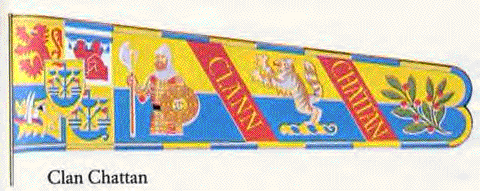
Clan Chattan is one of the oldest Highland clans; however its history is quite complex and almost has to be told in two separate parts as you cannot discuss the Clan Chattan history without also discussing the history of the Clan MacKintosh.
Clan Chattan means the clan of the cats. The Clan Chattan is believed to have descended from Gillichattan Mor, who was "Servant of St. Chattan" and had the galley coat-of-arms. Clan Chattan was founded in Lochaber at the close of the thirteenth century. The Clan consisted of various families or septs, bearing diverse names, who had banded themselves together under one chief for mutual protection.
Clan Mackintosh's earliest authentic ancestry is traced to Shaw MacDuff, son of the third Earl of Fife, who was of the Royal Family. MacDuff took the name of Mackintosh "Mac-an-Toisich" which means son of the Chief or Thane. In 1163 he came to the north to supress a rebellion. As a reward for his services, he was made keeper of the Royal Castle of Inverness. Shaw Mackintosh, the first Chief of the Clan, died in 1179.
There are many theories on the origin of this unique group of families which did not follow the ordinary pattern of other Scottish clans, but rather became a community or confederation, consisting of various descendents of the original ancestors. They were distinguished by the wildcat which figures so prominently in their heraldry. The most widely accepted, however, says they descended from Gillichattan Mor, the great servant of St Cattan. Gillichattan was probably the baillie, of the abbey lands of Ardchattan.
Around the time of Malcolm II they became possessed of lands at Glenloy and Loch Arkaig, where Torcastle became the chief¹s seat. Little is certain until the clan became established around Lochaber at the close of the thirteenth century.
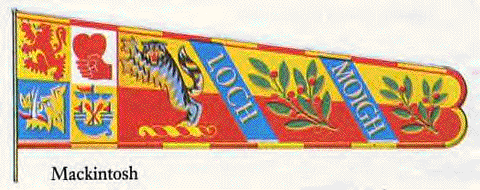
In 1291, Eva, daughter of Gilpatric, or Dougal Dall married Angus Mackintosh, sixth of Mackintosh.
The Chattan chief gave to Angus Mackintosh with his daughter Eva the chiefship of Clan Chattan and the lands of Glenloy and Loch Arkaig. Eva was descended from Gillichattan Mor and her father was Gilpatric, or Dougal Dall of Clan Chattan in Lochaber, sixth in line from Gillichattan Mor.The chieftainship of Clan Chattan was regarded as a hereditary honor, and the son-in-law became Chief in right of his wife, just as the husband of a Scottish countess became earl in her right. After his marriage to Eva, and upon the death of Dougal, Angus Mackintosh succeeded to the lands and chiefship of Clan Chattan, with the approval of the entire clan. Angus and Eva lived at Torcastle, but due to the enmity of Angus Og of Islay they soon withdrew to Rothiemurchus.
Angus was the seventh Chief of Clan Chattan and sixth Chief of Mackintosh.
The Camerons, claiming that the lands around Arkaig had been abandoned, occupied them by right of conquest. Thereafter a long and bitter feud was fought between the Camerons and Clan Chattan which lasted unitl 1666. In 1370 four hundred Camerons made a raid into Badenoch but while returning home with their spoils they were met at Invernahavon by a strong force of Mackintoshes supported by the MacPhersons and Davidsons. The Camerons were defeated, but the battle was the origin of feuding between the MacPhersons and the Davidsons. In 1503 the Camerons rebelled against the king and ravaged Badenoch. Despite several bloody encounters, it took some three years to quell the insurrection.
Prior to the fourteenth century, Clan Chattan appears to have been a conventional clan though little is known of it. Subsequently, however, it evolved into a confederation or alliance of clans made up of (a) the descendents of the original clan (Macphersons, Cattanachs, Macbeans, Macphails), (b) Mackintoshes and their cadet branches (Shaws, Farquharsons, Ritchies, McCombies, MacThomases), and (c) families not originally related by blood (MacGillivrays, Davidsons, Macleans of Dochgarroch, MacQueens of Pollochaig, Macintyres of Badenoch, Macandrews). By the eighteenth century the clans in and around Strathcairn (Shaw, Macbean, Macphail, MacGillivray) looked to Mackintosh as their chief, having none of their own, but whether this was Clan Chattan or Clan Mackintosh is unclear, the histories of both clans being inextricably entwined.
In the risings of 1715 and 1745 Clan Chattan declared for the Stuarts, and suffered as a consequence. Among the dead and captured after the Battle of Preston in 1715 were numbered many bearing Clan Chattan surnames, especially MacGillivrays. The Mackintosh chief was imprisoned until August 1716 and he died at Moy in 1731. When Bonnie Prince Charlie returned in 1745 to promote his father¹s claim to the throne, the chief of the Mackintoshes was an officer of George II in command of a company of the Black Watch. He did not rally to the prince¹s call to arms, but his wife, Anne, daughter of Farquharson of Invercauld, raised the confederation in his absence, selecting MacGillivray of Dunmaglas as commander. Under him the Clan Chattan Regiment fought at the Jacobite victory of Falkirk in 1746. It is of note that there were separate MacPherson and Farquharson regiments.
The suppression of the Highlands after the Forty-five undermined the nature of the confederation, and its members largely sought independent destinies. The major families continued to dispute the vestiges of power, but no more violently than in heated debate before the Court of the Lord Lyon. As early as September 1672, the MacPherson claim had been swept aside by the Lord Lyon, and Mackintosh was declared to be chief of the name of Mackintosh and of Clan Chattan.
The chiefs of Clan Mackintosh continued as captains of Clan Chattan until 1947, when Duncan Alexander Mackintosh of Torcastle was recognised by the Lord Lyon as thirty-first chief of Clan Chattan. The present chief lives in Zimbabwe.
Clan Chattan Bond of 1664
"Wee under subscryt, Gentlemen of the name of Clan Chattan, in obed- iene to His Majesty's authority, and Letters of concurrence granted by the Lords of His Majesty's Privie Council in favour of Lachlan Mackintoshie of Torcastle, our Chieffe, against Evan Cameron of Lochyield, and certain others of the name of Clan Cameron, and for the love and favour we beare to the said Lauchlan, do hereby faithfully promitt and engage ourselves everie one of us for himself, and those under his power, in case the prementional Evan Cameron and those of his kin, now rebells, do not agree with the said Lauch- lan anent their present differs and controversies before the third day of Feb- ruary next ensuing, that then and in that case, we shall immediately thereafter upon the said Lauchlan his call, rise with, fortify, concurr and assist the said Lauchlan in the prosecution of the commission granted against the said Evan, to the uttermost of our power, with all those of our respective friends, foll- owers, and defenders, whom we may stopp or lett, or who will anyway be counselled and advised by us to that effect. Now thereto we faithfully engage ourselves upon our reputation and credite and the faith and truth in our bodies, by these subscribed at Kincairne in the nineteent day of November and year of God, Sixteen Hundred, Sextie and Four Years."
It is signed by twenty-eight gentlemen, heads of families, including five Mackintoshes.
( To learn more about the affiliated clans and septs click on the names below )
Affiliated Clans


The Clan Macpherson look upon themselves as the senior male representatives of the ‘Old Clan Chattan’. During the 14th century they migrated from Lochaber to Badenoch after the defeat of the Comyns.
The descendants of Muireach the Parson became known as the Clan Mac a Phearson or the Clan Mhuirich of Badenoch and they occupied an important and sometimes independent position in the Highlands.
The Clan’s traditions are embodied in an annual Clan Gathering held at Newtonmore each August and at the famous Clan Museum there. The present Chief, Sir William Alan Macpherson of Cluny and Blairgowrie, lives at Newton Castle, Blairgowrie.
Septs
Cattanach, Clark, Clarke, Clarkson, Clerk, Currie, Fersen, Gillespie, Gillies, Gow, Keith, Lees, MacClerich, MacChlery, MacCurrach, MacGowan, MacKeith, MacLeish, MacLerie, MacLise, MacMurdo, MacMurdoch, MacMurrich, MacVurrich, Murdoch and Murdoson.
|


Farquhar Shaw, the fourth son of Alexander 3rd, Shaw of Rothiemurchus, was the ancestor of Clan Farquharson. His son married the heiress of Invercauld and the Clan gained its lands on Deeside.
Its most famous Chief was Finla Mor who consolidated the Clan and who carried the Royal Standard at the Battle of Pinkie in 1547.
In the 18th century, connections between Farquharson and Mackintosh were strengthened by the marriage of a daughter of the Farquharson Chief to the then Chief of Clan Chattan. ‘Colonel Anne’, as she was known, raised the Clan Mackintosh Regiment for Prince Charlie during the ’45. Their Chief today is Captain A. Farquharson of Invercauld MC.
Septs
Coutts, Farquhar, Findlay, Findlayson, Finlay, Finlayson, Grevsach, Hardie, Hardy, Leys, Lyon, MacCaig, MacCardney, MacEaracher, MacFarquhar, MacGruaig, MacHardie, MacKerchar, MacKerracher, MacKinlay, Pattison, Reach and Riach.
 
|
Septs of Clan Mackintosh which are a part of Clan Chattan
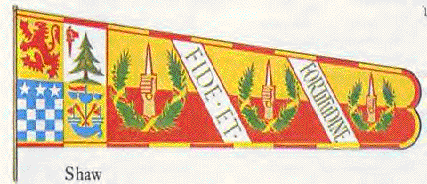
The history of the Shaws and the Mackintoshes is as deeply interwoven as the tartans they wear. Shaw and Mackintosh have a common stem which goes back to the Earls of Fife.
The word Shaw is a corrupt Anglicised rendering of part of the ancient Gaelic style Toisich meaning first, foremost or leader, and still the name given to the premier of Eire.
The founder was John, second son of Angus and Eva, heiress to Clan Chattan. His grandson, Shaw Mor, led the thirty champions of Clan Chattan to victory at the ordeal by battle on the North Inch of Perth in 1396. As a reward, the family were granted lands at Rothiemurchus near Aviemore. These later became the property of the Grant family.
The headquarters of the Clan, and Tordarroch Clan Centre Trust, are at Tordarroch in Strathnairn where the family moved in the 15th century after losing their stronghold in Rothiemurchus.
The present Chief, John Shaw of Tordarroch, lives in Fortrose on the Black Isle, Ross-shire.
Septs
Ayson of N.Z. Adamson, Esson, MacAy, MacHay, Shiach, Sheach, Sheath, Seith, Seth, Skaith, Scaith and Shay.
For more on Clan Shaw see the Clan Shaw page of this site.
 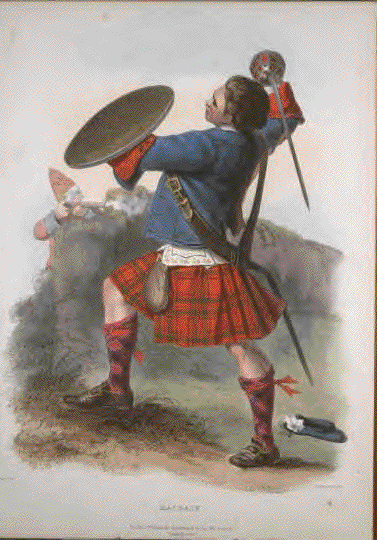 |
CLAN MACBEAN or MacBain
The progenitors of Clan Macbean came from Lochaber to Petty in the 14th century, seeking the protection of the Mackintoshes, having slain the Red Comyn’s steward. Although its numbers were heavily depleted at the Battle of Harlaw in 1411, the Clan remained an active member of the Confederation.
Gillies Macbean is particularly remembered for his bravery at the Battle of Culloden. Today there is a fine memorial park for the Clan in its ancestral lands at Kinchyle, overlooking Loch Ness near Dores. The present Chief, James McBain of McBain, lives in Arizona, USA.
Septs
Bain, Bean, McBain, MacBean, McBeath, MacBeth, Macilvian and MacVean.
 |
The Clan is descended from David Dubh, possibly a son of one of the early Chattan chiefs. The Davidsons feature in the 14th century, when they sought the protection of Clan Chattan, after the downfall of the Comyn family.
Their original lands were at Invernahavon, though the Castle of Davidson of Tulloch acquired in 1763 near Dingwall may also be linked to this particular Clan Davidson. The present Chief, Alister Davidson of Davidston, resides in New Zealand.
Septs
Davie, Davis, Dawson, Dow, MacDade, Macdaid, MacDavid and Kay.
|
CLAN MACLEAN OF DOCHGARROCH
Clann Thearlaich
The Macleans of Dochgarroch are descended from Charles, son of Maclaine of Lochbuie, a major branch in Mull of Clan Maclean. The family arrived in the area in 1394 and became known as the ‘Macleans of the North’.
Tearlach Maclean was Constable of Urquhart Castle, but after the Battle of Harlaw in 1411, his family sought the protection of Clan Chattan. The current Chief, The Very Rev Allan Maclean of Dochgarroch lives in Oban.
|
MacIntyre means ‘son of the carpenter’ so there are many families with the name in the Highlands.
The Clan Chattan MacIntyres appear to have been based in Badenoch and early records suggest that a Mackintosh chief took a MacIntyre bard, the family’s progenitor, under his protection in 1496.
|
CLAN MACPHAIL
Clann Phail
The headquarters of Clan Macphail at Inverarnie in Strathnairn date from the 16th century although the Clan is said to have been founded by Paul Cattanach – a name associated with the ‘Old Clan Chattan, in the 13th century.
Macphail of the ’45 was the last person to shake hands with Prince Charles Edward Stuart and to his death he never greeted anyone else with that hand.
|
Septs
MacPhail, Macphail, McFail, McPhaul, McFaul, Fail, Fall and McPaul.
The Macqueens of Clan Chattan are a small branch of an ancient Skye Clan. They became members in the 15th century after the marriage of Mora Macdonald of Moidart with Calum Beg Mackintosh, 10th of Mackintosh.
Revan, also known as Roderic mac Milmor vic Swen, who was in the wedding party, settled in Corrybrough in Strathdearn and the Clan took his name. Macqueen of Pollochaig is reputed to have killed the last wolf in Scotland in 1743.
|
Septs
MacCunn, MacSwan, MacSween, MacSwen, MacSwyde and Swan.
|
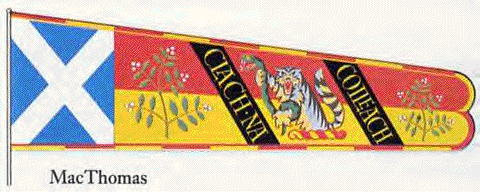
The Clan has numerous branches and various forms of the name. One of the branches claims descent from a son of William 7th of Mackintosh.
Clan MacThomas owned lands in Glenshee, Strathardle and Glenisla, some distance from the ancient territory of Clan Chattan. The present Chief is Andrew MacThomas of Finegand
Septs
|
Comb, Combie, McColm, McComas, McComb, McCombie, McComie, McComish,
Macomie, Macomish, Macthomas, Tam, Thom, Thomas, Thoms and Thomson.
Images on this page were gatherered from the web. No inference to thier ownership is made by this site.